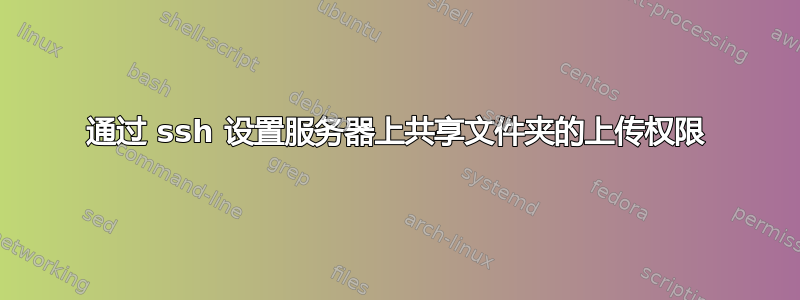
我使用 Ubuntu Server 17.04 设置了一个无头家庭文件服务器。我使用 SSH 通过 WiFi 从运行标准 Ubuntu 17.04 的笔记本电脑访问它。我发现 SSH(SFTP)足以满足我为家庭网络提供文件(例如音乐和照片)的需求。
现在我希望能够将文件上传到我服务器硬盘上的一个文件夹/dev/sda1,该文件夹当前已挂载为/media/a。它使用 ext4 Linux 文件系统,我使用命令挂载了它sudo mount /dev/sda1 /media/a。
我可以从终端运行 SSH 命令(通过使用 登录ssh username@servername),并且可以通过笔记本电脑上的 GUI 访问文件(文件 > 其他位置 > 连接到服务器 > sftp://用户名@服务器名称)。但是,当我尝试创建一个新文件夹时,它说
创建新文件夹时出错:权限被拒绝。
upload我尝试使用 设置文件夹(通过我的 ssh 会话新创建)的权限sudo chmod o=rwx /media/a/upload。但是,当我现在尝试通过笔记本电脑上的 GUI 在那里创建一个文件夹时,它说
创建新文件夹时出错:原因不明。
如何从我的笔记本电脑上传文件到我的服务器?
编辑:/etc/ssh/sshd_config根据要求,这是我的文件的内容:
# $OpenBSD: sshd_config,v 1.100 2016/08/15 12:32:04 naddy Exp $
# This is the sshd server system-wide configuration file. See
# sshd_config(5) for more information.
# This sshd was compiled with PATH=/usr/bin:/bin:/usr/sbin:/sbin
# The strategy used for options in the default sshd_config shipped with
# OpenSSH is to specify options with their default value where
# possible, but leave them commented. Uncommented options override the
# default value.
#Port 22
#AddressFamily any
#ListenAddress 0.0.0.0
#ListenAddress ::
#HostKey /etc/ssh/ssh_host_rsa_key
#HostKey /etc/ssh/ssh_host_ecdsa_key
#HostKey /etc/ssh/ssh_host_ed25519_key
# Ciphers and keying
#RekeyLimit default none
# Logging
#SyslogFacility AUTH
#LogLevel INFO
# Authentication:
#LoginGraceTime 2m
#PermitRootLogin prohibit-password
#StrictModes yes
#MaxAuthTries 6
#MaxSessions 10
#PubkeyAuthentication yes
# Expect .ssh/authorized_keys2 to be disregarded by default in future.
#AuthorizedKeysFile .ssh/authorized_keys .ssh/authorized_keys2
#AuthorizedPrincipalsFile none
#AuthorizedKeysCommand none
#AuthorizedKeysCommandUser nobody
# For this to work you will also need host keys in /etc/ssh/ssh_known_hosts
#HostbasedAuthentication no
# Change to yes if you don't trust ~/.ssh/known_hosts for
# HostbasedAuthentication
#IgnoreUserKnownHosts no
# Don't read the user's ~/.rhosts and ~/.shosts files
#IgnoreRhosts yes
# To disable tunneled clear text passwords, change to no here!
#PasswordAuthentication yes
#PermitEmptyPasswords no
# Change to yes to enable challenge-response passwords (beware issues with
# some PAM modules and threads)
ChallengeResponseAuthentication no
# Kerberos options
#KerberosAuthentication no
#KerberosOrLocalPasswd yes
#KerberosTicketCleanup yes
#KerberosGetAFSToken no
# GSSAPI options
#GSSAPIAuthentication no
#GSSAPICleanupCredentials yes
#GSSAPIStrictAcceptorCheck yes
#GSSAPIKeyExchange no
# Set this to 'yes' to enable PAM authentication, account processing,
# and session processing. If this is enabled, PAM authentication will
# be allowed through the ChallengeResponseAuthentication and
# PasswordAuthentication. Depending on your PAM configuration,
# PAM authentication via ChallengeResponseAuthentication may bypass
# the setting of "PermitRootLogin without-password".
# If you just want the PAM account and session checks to run without
# PAM authentication, then enable this but set PasswordAuthentication
# and ChallengeResponseAuthentication to 'no'.
UsePAM yes
#AllowAgentForwarding yes
#AllowTcpForwarding yes
#GatewayPorts no
X11Forwarding yes
#X11DisplayOffset 10
#X11UseLocalhost yes
#PermitTTY yes
PrintMotd no
#PrintLastLog yes
#TCPKeepAlive yes
#UseLogin no
#UsePrivilegeSeparation sandbox
#PermitUserEnvironment no
#Compression delayed
#ClientAliveInterval 0
#ClientAliveCountMax 3
#UseDNS no
#PidFile /var/run/sshd.pid
#MaxStartups 10:30:100
#PermitTunnel no
#ChrootDirectory none
#VersionAddendum none
# no default banner path
#Banner none
# Allow client to pass locale environment variables
AcceptEnv LANG LC_*
# override default of no subsystems
Subsystem sftp /usr/lib/openssh/sftp-server
# Example of overriding settings on a per-user basis
#Match User anoncvs
# X11Forwarding no
# AllowTcpForwarding no
# PermitTTY no
# ForceCommand cvs server
编辑:以下是评论中要求的各种命令的输出
username@servername:~$ findmnt /media/a
TARGET SOURCE FSTYPE OPTIONS
/media/a /dev/sdc1 ext4 rw,relatime,data=ordered
username@servername:~$ namei -lx /media/a
f: /media/a
Drwxr-xr-x root root /
drwxr-xr-x root root media
Drwxr-xr-x root root a
username@servername:~$ id
uid=1000(user) gid=1000(user) groups=1000(user),4(adm),24(cdrom),27(sudo),30(dip),46(plugdev),111(lxd),116(sambashare),117(lpadmin)
username@servername:~$ getfacl /media/a
getfacl: Removing leading '/' from absolute path names
# file: media/a
# owner: root
# group: root
user::rwx
group::r-x
other::r-x
username@servername:~$ mkdir -v /media/a/upload
mkdir: cannot create directory ‘/media/a/upload’: Permission denied
答案1
看起来您想要一个“粘性”目录,其中/tmp每个具有写权限的用户都可以创建条目,但他们不能更改目录本身或删除其他用户创建的条目。粘性位具有八进制掩码1000或符号t。
要设置“粘性”或“限制删除”标志:
sudo chmod +t /media/a
设置“粘性”标志和允许每个人创建目录条目:
sudo chmod a=rwxt /media/a
这手册页unlink(2)在其错误条件部分描述了粘性标志对目录的影响:
EPERM或者EACCES:包含路径名的目录设置了粘滞位(S_ISVTX),并且进程的有效 UID 既不是要删除的文件的 UID,也不是包含该文件的目录的 UID,并且该进程不具有特权(Linux:没有该CAP_FOWNER功能)。
也可以看看
答案2
尽管限制删除无主文件夹David 建议对于您的使用情况来说可能是一个好主意,但它并不是问题的根本原因。
chmod 的 o= 开关表示其他人(不是用户,不是组成员),不是所有人。我不认为这是你的想法。要为你设置读写权限,你需要使用 u= 开关,如下所示sudo chmod u=rwx /media/a/upload
当然,这假设您具有对父目录的写入权限,但您的问题表明您没有。您需要对目录具有写入权限才能在其中创建目录,这就是为什么您不能这样做,mkdir -v /media/a/upload因为您只有对 /media/a/ 的读取和执行权限
请注意,由于权限适用于 (U)ser (G)roup 和 (O)thers,如果您想要精细的访问控制,您需要从其当前 root:root 所有权更改用户或组或两者。有关 chown 的更多信息,请参见下文。
如果我的用户名是 ivan,并且我只希望对 media/a/upload 目录具有 rwx 访问权限,我会发出以下命令。
sudo chown ivan /media/a/upload (这将保持组状态不变)或更通用
sudo chown username:groupname /media/a/upload
其次是
sudo chmod u=rwx /media/a/upload
由于其他人可以通过 x 权限访问 /media/a/,因此您应该被允许遍历该目录,从而允许更改 /media/a/upload/ 上的所有权和权限设置
有关 chown 的更多信息,请参见man chown或https://linux.die.net/man/1/chown
有关 chmod 的更多信息,请参见man chmod或https://en.wikipedia.org/wiki/Chmod或者https://linux.die.net/man/1/chmod
资料来源:
man chown
man chmod
https://en.wikipedia.org/wiki/Chmod
編輯:更改文件夹权限和所有权这篇文章对这个话题进行了详细的讨论。


